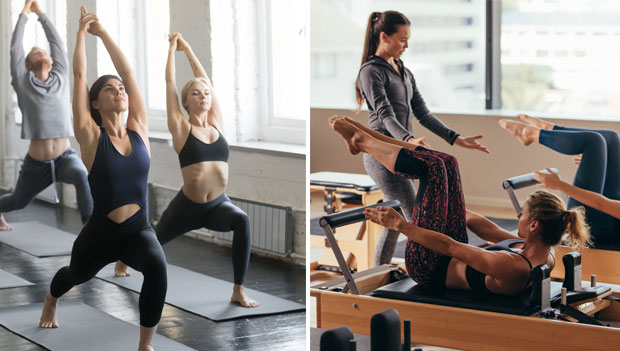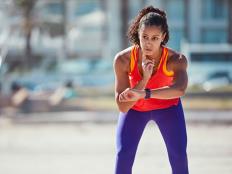
What is Yoga | Pilates vs. Yoga | Yoga Poses and Stretches for a Tight IT Band | Best Yoga Pants | Best Yoga Mats | Best Yoga Blocks | Best Yoga Bolster | Best Yoga Wheel | Best Yoga Blankets | Best Lululemon Yoga Mat
Ah, the age-old debate—Pilates vs. yoga. Pilates and yoga are two similar yet two completely different workouts. While both improve your flexibility and mobility, help you learn how to get in tune with your breath, and offer moments of peace and a deeper connection to yourself, they do it through different approaches and exercises.
To answer which one is better, we have to look at the similarities and differences as well as the potential health benefits of both. However, at the end of the day, the best way to know for sure is to try them out yourself and feel which one works better for you, your lifestyle, and your fitness level.
Benefits of Pilates
Known for its versatility and convenience, Pilates is a popular form of fitness that many people enjoy in their spare time, stretching and moving in all planes and directions. Even though its popularity grew with celebrity endorsements and it doesn't have a thousand-year origin story, Pilates still has a positive effect on both physical and mental health.
Regardless of your age and fitness level or whether you're a beginner or an avid practitioner, Pilates is bound to challenge you, improve your physical health, and have a positive effect on your state of mind.
Here are some of the most important benefits of Pilates:
Pilates Helps Reduce Pain
Studies have shown how specifically tailored Pilates exercises can have a positive effect on pain reduction, with the most significant improvement in back pain. This in turn has a positive effect on your mood and overall quality of life as it makes you more mobile and adept to perform your daily activities.
Pilates Helps Strengthen Your Core
Pilates is known for its emphasis on core work and exercises laser-focused on burning out your abs and obliques. The founder of Pilates, Joseph Pilates, created the exercises with a strong focus on the core as he believed that it's the ultimate foundation for everything else and that without a strong core, there's a greater risk for injury and pain. Research only proves him right.
Pilates Helps Improve Flexibility
Pilates is also known for its stretching exercises which get deep into the muscle fascia. These carefully-designed stretches tackle every muscle and help elongate them over time. Whether you're just beginning or you've been practicing for a while, you'll undoubtedly notice improvement with consistent practice.
Pilates Helps Improve Range of Motion
Another important aspect of Pilates is mobility or the movement of your joints. Pilates has specific exercises that help open up your hips, shoulders, wrists, and ankles, improving their range of motion and strengthening the muscles and tendons surrounding them. This is especially important for the elderly as it reduces the risk of falls.
Pilates Helps Improve Posture
As we age, our posture becomes a little less ideal and the sedentary lifestyles we all lead definitely don't help. Pilates has a variety of unilateral movements that focus on each side of the body individually and allows for the weaker parts to strengthen over time. The majority of other exercises are performed with both sides of the body at the same time which gives the opportunity for the stronger areas to take over.
Pilates contains many isolated movements which focus on only one muscle or muscle group at a time, helping to improve, strengthen, and tone each part separately. It also focuses on the alignment of joints and proper form which creates balance in the opposing muscles and improves overall stability and balance.
Benefits of Yoga
Yoga is an ancient discipline that originated in India thousands of years ago. Its vast benefits surpass the physical and although yoga brings almost the same benefits as Pilates does (improved posture, better range of motion, and improved flexibility), yoga is said to have greater benefits for your mental health. That’s because it forces you to slow down and focus on your breathing as you complete various yoga poses.
So, instead of focusing on flexibility and mobility, we'll discuss the health benefits that are unique to yoga.
Yoga Helps You Tune Into Your Breath
Yoga asanas or movements follow your breath. They last as long as your inhales and exhales do and help you get into a more meditative state every time you step on your mat. Yoga allows you to take a moment to fully appreciate your breath cycles and as you keep practicing, you'll notice your breath slowly becomes deeper, longer, and calmer.
Yoga Brings You to the Present Moment
Almost everyone starts going to yoga for the physical aspects and stays for the mental. By tuning into your own inhales and exhales, yoga practice helps bring you to the present moment, keeping your mind from racing about your to-do list and leaving you in the right here and now. This can be a breath of fresh air on busy days, giving you that much-needed feeling of rest and relaxation so you can recharge your batteries.
Yoga Improves Your Balance
In addition to improving your flexibility and mobility, yoga helps improve your core strength and balance. Even the most basic sequences have balancing poses and long holds that challenge your stability. By learning how to engage your core muscles and what's known as bandhas, you're able to work on your balance and improve its level dramatically in only a short period of time. This is extremely important as you age in order to prevent falls and injuries.
Yoga Improves Your Concentration and Focus
With balance and core strength comes concentration and focus. In the foundational eight-limb-yoga system (Ashtanga yoga), one of the main aspects is Drishti, or focus. Every yoga asana has a specific focal point to drive the energy and help you stay balanced and still. Over time, this level of focus and concentration translates into your daily life, helping you feel laser-focused thanks to a higher level of mental clarity.
Yoga Helps You Destress and Relax
Perhaps the biggest reason people keep coming back to yoga is the fact it helps them destress and relax. The blissful state of Shavasana or the corpse pose leaves almost everyone in a better state than when they first stepped on the mat. And it's potentially the greatest benefit of yoga at all.
Stress is known as the silent killer for a reason. It creeps up on you and wreaks havoc without you even realizing it. And once it becomes chronic, it's excruciatingly hard to repair the damage. Yoga helps you fight stress and its harmful side effects, one asana at a time.
The Differences Between Pilates and Yoga
There are many similarities between Pilates and yoga. Both of these activities help improve your flexibility and mobility, strengthen your core muscles and help you work on your balance, stabilize your posture and isolate your muscles, and bring you in sync with your breath. Still, there are some major differences.
The most important include:
- Yoga is a sequence of movements that usually flow and transition from one to the next one. Pilates might have a cohesive theme but not necessarily a flow.
- Yoga includes meditation and specific breathing techniques while Pilates doesn't.
- There are many different types of yoga while Pilates is usually not as variable.
- Yoga uses no equipment, only yoga blocks, and straps to help get deeper in poses and work on your balance. While some Pilates classes are free of equipment, others use a Pilates reformer machine to add more resistance and variety to your workouts.
The Verdict: Pilates or Yoga?
Both of these activities bring a plethora of physical and mental benefits. If you're looking for more of a physical workout, you'll definitely be challenged by both. But if you're interested in reaching a low-stress, meditative state, you might be more inclined to yoga. That being said, there's no real way to know for sure unless you try them out yourself. You might even decide that choosing one over the other is an impossible task and you'd rather have the option of practicing both.
What is Yoga | Pilates vs. Yoga | Yoga Poses and Stretches for a Tight IT Band | Best Yoga Pants | Best Yoga Mats | Best Yoga Blocks | Best Yoga Bolster | Best Yoga Wheel | Best Yoga Blankets | Best Lululemon Yoga Mat
Get ACTIVE on the Go


Couch to 5K®
The best way to get new runners off the couch and across the finish line of their first 5K.
Available for iOS | Android







Discuss This Article